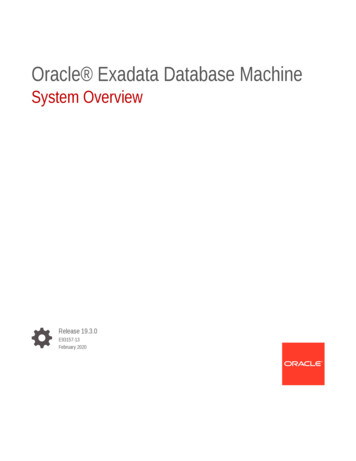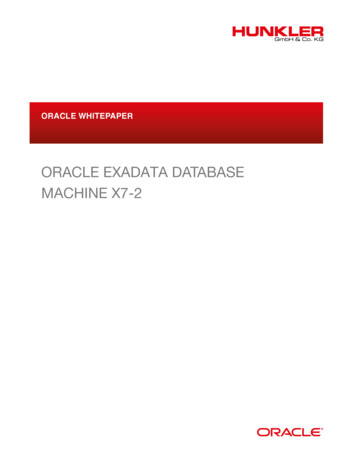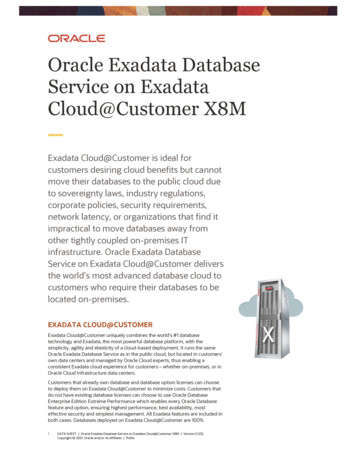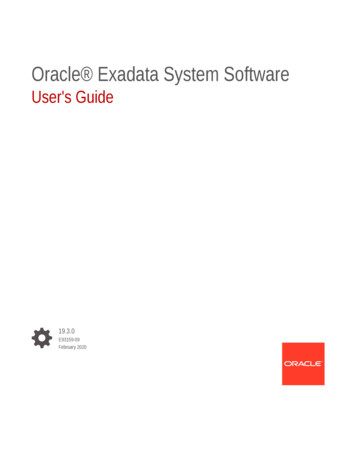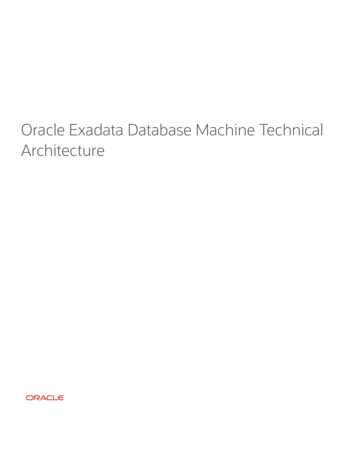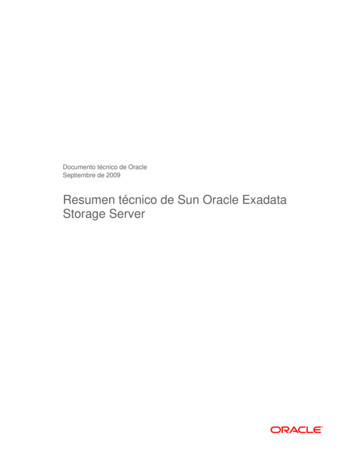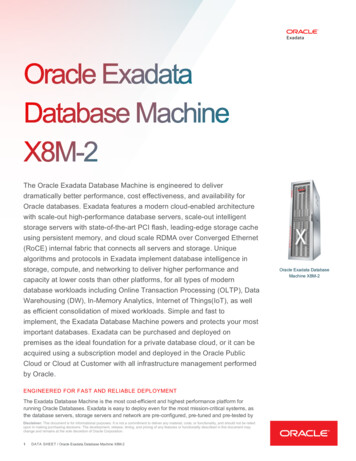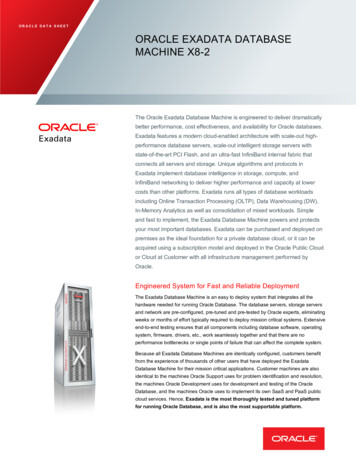
Transcription
ORACLE DATA SHEETORACLE EXADATA DATABASEMACHINE X8-2The Oracle Exadata Database Machine is engineered to deliver dramaticallybetter performance, cost effectiveness, and availability for Oracle databases.Exadata features a modern cloud-enabled architecture with scale-out highperformance database servers, scale-out intelligent storage servers withstate-of-the-art PCI Flash, and an ultra-fast InfiniBand internal fabric thatconnects all servers and storage. Unique algorithms and protocols inExadata implement database intelligence in storage, compute, andInfiniBand networking to deliver higher performance and capacity at lowercosts than other platforms. Exadata runs all types of database workloadsincluding Online Transaction Processing (OLTP), Data Warehousing (DW),In-Memory Analytics as well as consolidation of mixed workloads. Simpleand fast to implement, the Exadata Database Machine powers and protectsyour most important databases. Exadata can be purchased and deployed onpremises as the ideal foundation for a private database cloud, or it can beacquired using a subscription model and deployed in the Oracle Public Cloudor Cloud at Customer with all infrastructure management performed byOracle.Engineered System for Fast and Reliable DeploymentThe Exadata Database Machine is an easy to deploy system that integrates all thehardware needed for running Oracle Database. The database servers, storage serversand network are pre-configured, pre-tuned and pre-tested by Oracle experts, eliminatingweeks or months of effort typically required to deploy mission critical systems. Extensiveend-to-end testing ensures that all components including database software, operatingsystem, firmware, drivers, etc., work seamlessly together and that there are noperformance bottlenecks or single points of failure that can affect the complete system.Because all Exadata Database Machines are identically configured, customers benefitfrom the experience of thousands of other users that have deployed the ExadataDatabase Machine for their mission critical applications. Customer machines are alsoidentical to the machines Oracle Support uses for problem identification and resolution,the machines Oracle Development uses for development and testing of the OracleDatabase, and the machines Oracle uses to implement its own SaaS and PaaS publiccloud services. Hence, Exadata is the most thoroughly tested and tuned platformfor running Oracle Database, and is also the most supportable platform.
ORACLE DATA SHEETThe Oracle Exadata Database Machine runs the standard Oracle Database. Therefore,any application that uses the Oracle Database today can be easily and seamlesslyKEY FEATURES Up to 912 CPU cores and 28.5TB memory perrack for database processing Up to 576 CPU cores per rack dedicated toSQL processing in storage From 2 to 19 Database Servers per rack From 3 to 18 Storage Servers per rack Up to 920 TB of Flash capacity (raw) per rack Up to 3.0 PB of disk capacity (raw) per rack Hybrid Columnar Compression often delivers10X-15X compression ratios 40 Gb/second (QDR) InfiniBand Network Complete redundancy for high availabilitymigrated to use the Exadata Database Machine with no changes to the application.Databases can also be easily migrated off Exadata, eliminating “lock-in” concerns.Customers thinking of deploying databases on the Public Cloud can be confident thatExadata provides 100% compatibility between on-premises and public cloud,enabling seamless migration to the public cloud as well as hybrid cloud deployments.Extreme System Scalability and Growth with ElasticConfigurationsThe Exadata Database Machine uses a scale-out architecture for both databaseservers and storage servers. As workloads grow, database CPUs, storage, andnetworking are added to grow an Exadata Database Machine in a balanced fashion toscale without bottlenecks. The architecture allows elastic, seamless expansion fromsmall to extremely large configurations to accommodate evolving workloads of any size.KEY BENEFITS Pre-configured, pre-tested system optimizedfor all database applications Uncompressed I/O bandwidth of up to 350GB/second per full rack from SQL Ability to perform up to 4.8M 8K database readI/O operations, or 4.3M 8K Flash write I/Ooperations per second per full rack Easily add compute or storage servers to meetthe needs of any size application Scale by connecting multiple ExadataDatabase Machine X8-2 racks or ExadataStorage Expansion Racks. Up to 18 racks canbe connected by simply adding InfiniBandcables and internal switches. Largerconfigurations can be built with externalInfiniBand switchesA high-bandwidth low-latency 40 Gb/second InfiniBand network connects all thecomponents inside an Exadata Database Machine. Specialized database networkingprotocols over InfiniBand provide much lower latency and higher bandwidth than ispossible using generic communication protocols. This ensures both faster response timefor OLTP operations, and higher throughput for analytic workloads. External connectivityto the Exadata Database Machine is via standard 10 Gigabit or 25 Gigabit Ethernet.Exadata Database Machine is the most versatile database platform. The ExadataX8-2 Database Machine uses powerful database servers each with two 24-core x86processors and 384 GB of memory (expandable up to 1.5 TB). Exadata also uses scaleout, intelligent storage servers available in two configurations – High Capacity (HC) orExtreme Flash (EF). HC Storage Servers have four NVMe PCI Flash cards each with 6.4TB (raw) Exadata Smart Flash Cache and twelve 14 TB 7,200 RPM disks. EF StorageServers have an all-Flash configuration with eight NVMe PCI Flash drives, each with 6.4TB (raw) storage capacity. The minimal configuration of an Exadata Database Machineconsists of two database servers and three storage servers, which can be expandedinto elastic configurations adding more database and/or storage severs within thesame rack. Elastic configurations provide a flexible and efficient mechanism to meet anysize business need.In addition to upgrading within a rack, multiple racks can be connected using theintegrated InfiniBand fabric to form even larger configurations. For example, a systemcomposed of four racks is simply four times as powerful as a single rack system: itprovides quadruple the I/O throughput, quadruple the storage capacity, and quadruple“I would recommend Exadata as a platformfor performance, reliability and ease ofsupport. Those three things mean verymuch to me in my daily life.”- Richard EwaldSenior Technical ArchitectSprint2 ORACLE EXADATA DATABASE MACHINE X8-2the processing power. It can be configured as a large single system or logicallypartitioned for consolidation of multiple databases. Scaling out is easy, as Oracle RealApplication Clusters (RAC) can dynamically add more processing power, and AutomaticStorage Management (ASM) can dynamically add more storage capacity.
ORACLE DATA SHEETRELATED PRODUCTS Oracle Database Exadata Cloud Service Oracle Database Exadata Cloud at Customer Oracle Exadata Database Machine X8-8 Oracle Exadata Storage Expansion Rack X8-2 Oracle Exadata Storage Server X8-2 PlusInfiniBand Infrastructure Oracle Exadata Database Server X8-2 PlusInfiniBand Infrastructure Oracle SuperCluster Oracle Database 11g, 12c, 18c and 19c Real Application Clusters Partitioning Multitenant Database In-Memory Advanced Compression Advanced Security Active Data GuardFig 1: Elastic Scale-out to Multi-rack ExadataWhen even larger storage capacity is required, the Oracle Exadata Storage ExpansionRack is available. The Exadata Storage Expansion Rack enables customers to grow thestorage capacity and bandwidth of any Exadata Database Machine. It is designed for GoldenGatedatabase deployments with very large amounts of data, including historical or archive Real Application Testingdata, backups, documents, images, XML, JSON and LOBs. The storage expansion rack OLAPconnects to the Exadata Database Machine using the integrated InfiniBand fabric and is Advanced Analyticsvery simple to configure with a few simple commands, as there are no LUNs or mount Business Intelligencepoints. The starting configuration of the Oracle Exadata Storage Expansion Rack Enterprise Managerconsists of four storage servers and can be expanded with additional storage servers. Oracle Linux Oracle Virtual MachineExadata Database Machines protect your investment as newer generation servers andstorage can be incorporated seamlessly into existing Exadata Database Machines.Similarly, new software releases are compatible with most previous generation ExadataDatabase Machines.Extreme Flash Storage Server: Record-breaking I/OPerformanceRELATED SERVICESThe following services are available from Oracle:Exadata Extreme Flash (EF) Storage Server, first introduced with Exadata X5, is the Advanced Customer Servicesfoundation of a database-optimized all-Flash Exadata Database Machine. Each EF Oracle Premier Support for SystemsStorage Server contains eight 6.4 TB state-of-the-art Flash Accelerator F640 NVMe PCI Oracle Platinum ServicesFlash drives, offering 51.2TB raw Flash capacity per EF Storage Server. Exadata X8 Consulting Servicesuses state-of-the-art Flash memory technology for improved speed, power efficiency, Oracle University coursesand endurance compared to previous generations of Flash. The enterprise grade Flashused in Exadata X8 have an expected endurance of 8 years or more for typical databaseworkloads. This is very different from consumer-grade Flash that can potentiallyexperience performance degradations or fail unexpectedly after a few years of usage. Inaddition, Exadata delivers ultra-high performance by placing the Flash devices directly3 ORACLE EXADATA DATABASE MACHINE X8-2
ORACLE DATA SHEETon the high speed PCI bus rather than behind slow disk controllers and directors. Finally,Exadata Flash uses state-of-the-art NVMe (Non-Volatile Memory Express) Flash toachieve extremely low latency and CPU overhead.Flash performance is often limited and bottlenecked in traditional storage architectures.In contrast, Exadata uses a combination of scale-out storage, InfiniBand networking,database offload, and PCI Flash to deliver extremely high performance from Flash. Atraditional full rack Exadata Database Machine X8-2, with 8 database servers and 14Extreme Flash storage servers, can achieve up to 350 GB per second of analytic scanbandwidth from SQL, and 0.25 ms Database I/O latency at 3.5 Million Flash IOPSwhen running database workloads. A slightly different full rack combination, with 11database servers and 11 Extreme Flash storage servers, can achieve up to 6.57 Millionrandom 8K database read and 5.72 Million random 8K Flash write I/O operationsper second (IOPS), which is an industry record for database workloads.“Oracle Exadata enabled seamless andrapid migration of our cloud-based,integrated business applications, requiredno major modifications, and helped usreduce costs. With Oracle, we dramaticallyimproved our batch processing speed by241x and overall system performance by 3x,enabling us to improve operating efficiencyfor our daily, critical tasks and to enhancecustomer service.”- Kyoji KatoExecutive Officer and GMDaiwa HouseThis performance is orders of magnitude faster than traditional storage arrayarchitectures, and it is also much faster than current all-Flash storage arrays. These arereal-world end-to-end performance figures measured running SQL workloads withstandard 8K database I/O sizes inside a single rack Exadata system, unlike storagevendor performance quotes that are usually based on small I/O sizes and low-level I/Otools and therefore are many times higher than can be achieved from SQL workloads.Fig 2: Flash Accelerator PCIe Card“Oracle Exadata Database Machine ishelping to transform our business. Our SAPenvironment, one of the world’s largest, cannow support twice as much throughput withimproved stability.”- Milt SimondsDirector, Enterprise Platform DeliveryAmerisourceBergen CorporationHigh Capacity Storage Server: Tiered Disk and Flash DeliverCost of Disk with Performance of FlashThe second Exadata storage option is the Exadata X8-2 High Capacity (HC) StorageServer. This server includes twelve 14 TB SAS disk drives with 168 TB total raw diskcapacity. It also has four Flash Accelerator F640 NVMe PCIe cards with a total rawcapacity of 25.6 TB of Flash memory. Exadata Flash in a High Capacity Storage Servercan be used directly as Flash disks, but is almost always configured as a Flash cache(Exadata Smart Flash Cache) in front of disk storage to deliver the best performance.4 ORACLE EXADATA DATABASE MACHINE X8-2
ORACLE DATA SHEETExadata Smart Flash Cache automatically caches frequently accessed data whilekeeping infrequently accessed data on disk, delivering the high I/O rates and fastresponse times of Flash with the large capacity and low cost of disk. The Exadata SmartFlash Cache uniquely understands database workloads and knows when to avoidcaching data that the database will rarely access or is too big to fit in the cache.For example, Exadata doesn’t cache I/Os caused by backups, large table scans, ortemporary results that will be quickly deleted. In addition to automatic caching,administrators can optionally provide SQL directives to ensure that specific tables,indexes, or partitions are preferentially retained in the Flash cache. A single full rackExadata Database Machine X8-2, with 8 database servers and 14 High Capacity storageservers can achieve up to 350 GB per second of analytic scan bandwidth from SQL,and up to 4.8 Million random 8K read I/O operations per second (IOPS) from SQL,and 0.25 ms I/O latency at 2.7 Million Flash IOPS when running database workloads.It is common for hit rates in the Exadata Smart Flash Cache to be over 95%, or even99% in real-world database workloads. Such high Flash cache hit rates mean thatExadata Smart Flash Cache provides an effective Flash capacity that is many timeslarger than the physical Flash. For example, a full rack Exadata Database Machine X8-2with 8 database servers and 14 High Capacity Storage Servers often has an effectiveFlash capacity equal to the usable disk capacity of 700 TB.“We chose Oracle Exadata because itoffered a complete solution . we’ve createddaily financial reports 4x faster and liquidityrisk reports 7x faster to consistently meetour service-level agreement, improvedcredit risk management, and reduced ourdata center footprint.”- Vaibhav SamantSenior Vice President, ITHDFC Bank Ltd.The Exadata Smart Flash Cache also caches database block writes using Exadata WriteBack Flash Cache technology. Write caching eliminates disk bottlenecks in large scaleOLTP and batch workloads. The Flash write capacity of a single full rack ExadataDatabase Machine X8-2 with 8 database servers and 14 High Capacity Storage Serversexceeds 4.3 Million 8K write I/Os per second. The Exadata write cache is transparent,persistent, and fully redundant. The I/O performance of the Exadata Smart Flash Cacheis comparable to dozens of enterprise disk arrays with thousands of disk drives.The automatic data tiering between RAM, Flash and disk implemented in Exadataprovides tremendous advantages over other Flash-based solutions. Many storagevendors have recognized that the architecture of their traditional storage arraysinherently bottlenecks the performance of Flash and therefore have developed newFlash-only arrays. These Flash-only arrays deliver higher performance than traditionalarrays but give up the cost advantages of smart tiering of data between disk and Flash,as the overall size of data that can benefit from Flash is limited to the size of expensiveFlash. And these Flash arrays are unable to benefit from Exadata’s unique storageoptimization technologies. Data deduplication provided by some Flash arrays is veryeffective for Virtual Desktop Infrastructure (VDI) environments, but not for databases.Exadata not only delivers much more capacity than generic all-Flash arrays, it alsodelivers better performance. Flash-only storage arrays cannot match the throughput of“None of the reports takes more than 10minutes. It was taking 3-4 hours before, nowit completes in 3 minutes. It sounds like unreal but it is real.”- Finance UserTurkcell5 ORACLE EXADATA DATABASE MACHINE X8-2Exadata's integrated and optimized architecture with full InfiniBand based scale-out, fastPCI Flash, offload of data intensive operations to storage, and algorithms throughout thatare specifically optimized for databases.
ORACLE DATA SHEETExtended Capacity Storage Server: Much Lower CostExadata Storage for Low Use DataNew for Exadata X8, a third Exadata storage option has been introduced - the ExadataX8-2 Extended (XT) Storage Server.Each Exadata XT Storage Server includes twelve 14 TB SAS disk drives with 168 TBtotal raw disk capacity. To achieve a lower cost, Flash is not included, and storagesoftware is optional.This new storage option enables customers to extend the operational and managementbenefits of Exadata to rarely accessed data that must be kept online. This lower-costaddition to the Exadata Storage Server lineup delivers Exadata class benefits: Efficient – The XT server offers the same high capacity as the HC Storageserver, including Hybrid Columnar Compression Simple – The XT server adds capacity to Exadata while remaining transparentto applications, transparent to SQL, and retains the same operational model“The heart and soul of our stack right now isOracle Exadata Database Machine. WithOracle Exadata, we’ve been able to reducequeries from days to minutes, and thosethat used to take minutes to seconds.”- Chris WonesEnterprise ArchitectDunnhumby Secure – The XT server enables customers to extend the same security modeland encryption used for online data to low-use data, because it is integratedwithin the same Exadata Fast and Scalable – Unlike other low-access data storage solutions, the XTserver is integrated to the Exadata fabric, for fast access and easy scale-out Compatible – The XT server is just another flavor of Exadata Storage server –you can just add XT servers to any Exadata rackWith Exadata X8-2 Extended (XT) Storage Server enterprises particularly in Finance,Insurance, and Telecommunications can meet their long-term data retention compliancerequirements with the same trusted and continually validated Exadata solution, avoidingthe operational risks and costs of managing information lifecycle on two or moreplatforms.Accelerating Database Processing with Smart SystemSoftwareAs data volumes continue their fast growth, conventional storage arrays struggle toquickly transfer data from disk and Flash to database servers at a rate that keeps theCPUs busy. Modern servers with dozens of CPU cores can consume data at many tensto hundreds of gigabytes a second. This is far faster than conventional storage arrays“[With Exadata] We can more quicklyprocess 65 billion daily transactions for datacharging, while providing real-timeinformation for customer inquiries,increasing customer satisfaction, andreducing costs.”- Jin Hyung LeeICT Team Manager, NetworkingEngineeringSK Telecom6 ORACLE EXADATA DATABASE MACHINE X8-2can deliver data through their storage controllers and the storage network.What enables Exadata’s unparalleled performance without any of the bottlenecks oftraditional storage arrays is Exadata System Software. This software powers theExadata storage servers, providing a unique highly efficient database-optimized storageinfrastructure. Each Exadata Storage Server has two 16-core x86 processors that areused to offload database processing, and a rack of Exadata Database Machine can havea total of up to 576 processor cores in the storage servers able to offload the databaseservers. The CPUs in the storage servers do not replace database CPUs. Instead they
ORACLE DATA SHEETaccelerate database intensive workloads similar to how graphics cards accelerate imageintensive workloads.One of the many unique features of Exadata System software is Smart Scantechnology, which offloads data intensive SQL operations from the databaseservers directly into the storage servers. By pushing SQL processing to the storageservers, data filtering and processing occur immediately and in parallel across all storageservers, as data is read from disk and Flash. Only the rows and columns that aredirectly relevant to a query are sent to the database servers.For example, if a query is executed to identify the customers who placed sales ordersover 1000 in the month of March, an Exadata system will offload the scanning of thetable to the Exadata storage, filter out all sales orders that are less than 1000, filter outsales orders not in March, and extract just the relevant customer information. Thisreduces the data transferred to the database servers by orders of magnitude. ThusSmart Scan greatly accelerates query execution, eliminates bottlenecks, and significantlyreduces the CPU usage of the database servers.“Exadata is the heart of the booking engine,and we cannot operate as a business, wecannot sell tickets without it.”- James CallaghanChief TechnologistWestjetStorage Index is another powerful unique capability of Oracle Exadata System softwarethat helps avoid unnecessary I/O operations and improves overall performance. Thestorage index, maintained in-memory at the storage server, tracks summary informationfor table columns contained in a storage region on that storage server. When a queryspecifies a WHERE clause, Exadata System software examines the storage index usinga Bloom filter to determine if rows with the specified column value might exist in a regionof disk on the storage server. If the column value doesn’t exist in the Bloom filter, thenscan I/O in that region for that query is skipped. Storage Indexes make many SQLoperations run dramatically faster because large numbers of I/O operations areautomatically replaced by a few in-memory lookups.Besides the intrinsic capabilities of Exadata System software, the combination of OracleDatabase software, Exadata System software and Exadata infrastructure enablesseveral additional unique capabilities that offer unparalleled performance levels for OLTPworkloads. For example, Exafusion Direct-to-Wire Protocol uniquely allows databaseprocesses to read and send Oracle Real Applications Cluster (Oracle RAC) messagesdirectly over the InfiniBand network using Remote Direct Memory Access (RDMA),bypassing the OS kernel and networking software overhead. This improves the responsetime and scalability of Oracle RAC OLTP configurations on Oracle Exadata DatabaseMachine, especially for workloads with high-contention updates.In some OLTP workloads, more than half of remote reads are for Undo Blocks to satisfyread consistency. Exadata uniquely leverages ultra-fast RDMA to read UNDO blocksfrom other database instances, further improving OLTP performance.The Smart Fusion Block Transfer capability uniquely improves performance of a RACOLTP configuration further by eliminating the impact of redo log write latency, especially“Exadata delivers an amazing 20xcompression for our Data Warehouse.”- Jonathan WalshHead of BI & DWMorrisons, Plc.when hot blocks need to be transferred between sending and receiving nodes. The blockis transferred as soon as the I/O to the redo log is issued at the sending node, withoutwaiting for it to complete. Oracle internal tests show that Smart Block Transfer increasesthroughput (about 40% higher) and decreases response times (about 33% less) forcommunication-intensive workloads.7 ORACLE EXADATA DATABASE MACHINE X8-2
ORACLE DATA SHEETTo further accelerate OLTP workloads, the Exadata Smart Flash Cache implements aunique algorithm to ensure low latency of database log writes called Exadata SmartFlash Logging. The time it takes to commit user transactions or perform critical updatesis very sensitive to the latency of log writes. Smart Flash Logging takes advantage of theFlash memory in Exadata storage combined with the high speed RAM memory in theExadata disk controllers to reduce the average latency of log writes and avoid thelatency spikes that occur in other Flash solutions.In addition, Exadata uniquely uses Machine Learning to implement AutomaticIndexing with Oracle Database 19c. Automatic Indexing continually analyzes executingSQL and creates new indexes to accelerate performance. Automatic Indexingcontinuously learns and tunes the database as the underlying data model or usagepatterns change.Exadata also uniquely implements Real Time Statistics gathering as DML operationsinsert, update or delete data. Real Time Statistics allows the SQL optimizer to adaptplans dynamically as the distribution of data changes.Optimizing Storage Use and I/O Through CompressionThe Exadata Storage Server provides a unique compression capability called HybridColumnar Compression (HCC) that enables dramatic reductions in storage forlarge databases. Hybrid Columnar Compression technology is an innovative method oforganizing data within a database table that uses a combination of both row andcolumnar methods for storing data. This hybrid approach achieves the compressionbenefits of columnar storage, while avoiding the performance shortfalls of a purecolumnar format.With Hybrid Columnar Compression, Exadata enables the highest levels of datacompression possible with Oracle databases, and provides substantial cost-savings andperformance improvements due to reduced I/O, especially for analytic workloads.Storage savings is data-dependent and often ranges from 5x to 20x. Average storagesavings is an industry-leading 10x. On conventional systems, enabling high datacompression has the drawback of reducing performance as it adds the load ofdecompression to the CPU. Because the Exadata Database Machine is able to offloaddecompression to processors in Exadata storage, and in addition there is reduced I/Oneed because of the high compression achieved, most analytic workloads run fasterusing Hybrid Columnar Compression than without it.Two modes of Hybrid Columnar Compression are available. Warehouse compressionmode is suitable for read-intensive workloads and provides large storage savings andenhanced analytic performance. Archive compression mode provides the highestdegree of compression and is targeted at data that is seldom accessed but still must bekept online. In addition, this data can now be seamlessly stored on the XT storage serverfor further cost reduction.On OLTP systems, Hybrid Columnar Compression can be used to compress older, lessactive data while newer, more active and update-intensive data can be compressedusing Advanced Row Compression. Oracle Database Release 18c and above providesthe ability to change the type of compression used by individual table partitions online8 ORACLE EXADATA DATABASE MACHINE X8-2
ORACLE DATA SHEET(even if there are global indexes on the table), to ensure seamless tiering acrossdifferent compression types as data ages and becomes less active.For data analytics, Exadata Smart Flash Cache implements a unique algorithm toaccelerate reporting and analytical queries, called Exadata Columnar Flash Cache.Columnar Flash Caching implements a dual format architecture in Exadata Flash byautomatically transforming frequently scanned Hybrid Columnar Compressed data into apure columnar format as it is loaded into the Flash cache. Smart scans on pure columnardata in Flash run faster because they read only the selected columns, reducing FlashI/Os and storage server CPU consumption. This accelerates reporting and analyticqueries while maintaining excellent performance for OLTP-style single row lookups.Fault Tolerant and Fastest Database In-Memory Machine forAnalytics and Mixed WorkloadsExadata is the ideal platform for running Oracle Database In-Memory. Oracle DatabaseIn-Memory on Exadata does not require all data to reside in memory. Data can be storedacross multiple tiers of storage, with the hottest data in memory providing extremely highquery performance, active data on Flash providing very high I/O throughput, and lessactive or older data on disk at a very low cost. A single query can access data from allthree tiers: memory, Flash and disk, completely transparently. This allows Exadatato run faster, support higher capacities and deliver lower costs than competing products.In addition, Exadata uniquely implements In-Memory columnar formats in FlashCache. This feature extends the Exadata Columnar Flash Cache by automaticallytransforming data into In-Memory columnar formats as it is loaded into Flash cache.Smart Scans also process multiple column values with a single instruction by leveragingultra-fast Single Instruction Multiple Data (SIMD) Vector instructions. Smart Scan resultsare passed back to the database server in Oracle Database In-Memory formats, furtherreducing the load on database server CPUs. The effect is to seamlessly extend the InMemory columnar store size from DRAM capacity in the database server to Flashcapacity in storage servers. An Exadata X8-2 Full Rack HC has 360 TB of Flash Cache,capable of servicing some of the largest in-memory workloads. Databases not usingOracle Database In-Memory still benefit from Exadata Columnar Flash Cache withoutthe vector processing optimizations.Exadata uniquely implements Fault Tolerant memory duplication for OracleDatabase In-Memory. On a generic cluster configuration, when a server node fails, thein-memory data on that node is lost, and it takes many minutes to repopulate the inmemory data on a surviving node. During this time, analytic queries will run orders ofmagnitude slower. This means generic platforms will fail to meet business SLAs.However, on Exadata, Fault-Tolerant memory duplication can eliminate this slowdown byduplicating any subset of the in-memory data across the clustered database servers. If adatabase server fails, queries
The Oracle Exadata Database Machine runs the standard Oracle Database. Therefore, any application that uses the Oracle Database today can be easily and seamlessly migrated to use the Exadata Database Machine with no changes to the application. Databases can also be easily migrated off Exadata, eliminating "lock-in" concerns.
